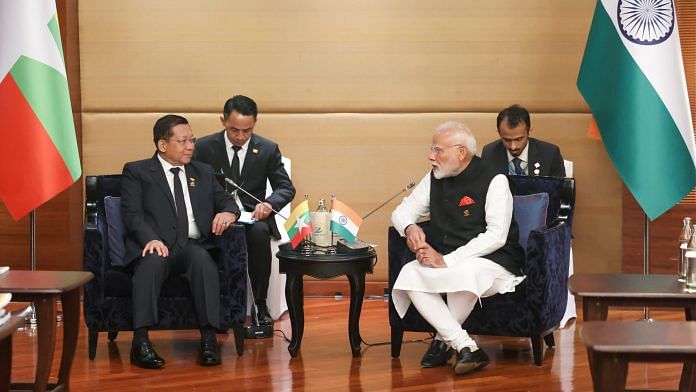The dust had barely settled over Operation Sindoor when China decided to rename 27 places in Arunachal Pradesh. Security forces killed 10 militants in Manipur near the Myanmar border. While Operation Sindoor was underway, New Delhi didn’t just block dozens of news channels and social media handles from Pakistan; it also blocked six Bangladeshi news channels that beam into India via YouTube, allegedly for spreading misinformation about the situation on the western border. At the time of writing, those channels remain off-air for Indian audiences.
Viewed in isolation, these developments may seem disconnected and minor, especially compared to India’s troubles on the western front. But taken together, they send a loud, clear, and unmistakable signal: there are good reasons for growing disquiet on India’s eastern front.
It is a sprawling frontier. India’s border with Myanmar stretches 1,643 km, with China 3,488 km, and with Bangladesh 4,096 km — a total of 9,227 km, roughly three times the length of the India–Pakistan border.
This total excludes India’s borders with Nepal and Bhutan, two neighbours with whom New Delhi’s ties are far more stable than with the rest of the region. Relations with Myanmar may not yet be beyond salvage. But with the US and Russia dipping their fingers into a pie dominated by China, there are no guarantees. Ties with Bangladesh were smooth until Sheikh Hasina was ousted as Prime Minister. Since then, Dhaka has moved closer to Pakistan. And during Operation Sindoor, China laid its cards on the table.
In such a fraught neighbourhood, the old diplomatic principle — ‘my enemy’s enemy is my friend’ — is no longer an option for India. It urgently needs to find alternative strategies to prevent a crisis from erupting in the east.
Also read: Myanmar crisis is a security threat for India’s eastern front. China’s shadow is looming
Enemy’s enemy
For the first time since Operation Sindoor — and the fifth since 2017 — China flexed its muscle earlier this week at the Arunachal Pradesh border by renaming places within the Indian state. This time, the number of places renamed was 27 — three fewer than last year — and included five inhabited areas, 15 mountains, four passes, two rivers, and a lake. Had these claims been made during Operation Sindoor, India would have found it harder to dismiss them as “vain and preposterous,” as mere PSYOPs or propaganda. Beijing’s backing of Islamabad in the past week has left India in no doubt: Pakistan, long considered India’s foe, is now firmly China’s friend — and vice versa.
A recovery in India’s relationship with Bangladesh, which went downhill following the ouster of Hasina last August, seems unlikely for now. The latest blow: the interim government, led by Chief Adviser Muhammad Yunus, has banned Hasina’s party, the Awami League. Hasina is in exile in New Delhi. Dhaka has formally requested her extradition so she can be tried for alleged “crimes against humanity” in Bangladesh’s International Crimes Tribunal. India has not responded. Extradition is not an option — New Delhi favours early elections in that country. But in the meantime, Dhaka slips further into Islamabad’s embrace.
Myanmar, meanwhile, holds strategic value for India on many fronts. It is the only land bridge to Southeast Asia. When the Kaladan Multi-Modal Transit Transport project and the India–Myanmar–Thailand Trilateral Highway are completed, they will change the parameters of trade and security in the region. India also maintains ties with the junta to counter China’s influence and preserve its access to the strategic Bay of Bengal.
That very influence drew US attention. In 2022, Washington passed the Burma Act, pledging “humanitarian aid, support for the democracy movement, and sanctions against those persons/entities funding the unlawful regime.” But Donald Trump’s withdrawal of foreign aid has significantly reduced US involvement. China’s domination in Myanmar now goes largely unchallenged.
The UN Secretary-General’s March proposal to establish a humanitarian corridor from Bangladesh to Myanmar’s Rakhine province — to facilitate the return of displaced Rohingyas — has divided opinion in Dhaka. If the plan proceeds, its fallout is something India will have to watch closely.
After the showdown on its western front and the global ripples that followed, India’s plate is full. The last thing it needs is to leave its eastern flank vulnerable to proxy wars that could prove just as debilitating — and just as costly — as a direct military confrontation.
Monideepa Banerjie is a senior journalist based in Kolkata. She tweets @Monideepa62. Views are personal.
(Edited by Prashant)







Hi Ms. Banerjie! What about the troubles rocking West Bengal one after the other? The state government seems to have made a habit of losing cases in the Supreme Court.
What would the unemployed “teachers” do now? Are reports of further investigations into other such teacher appointments true? Is Bengal, under the current administration, soaked under corruption?